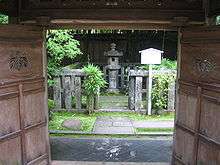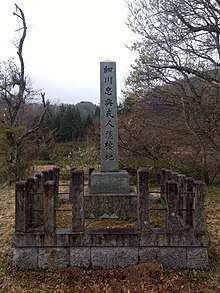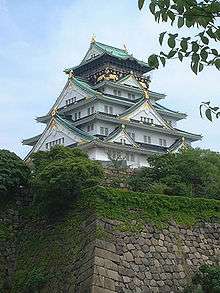Hosokawa Gracia

Hosokawa Tama (細川玉), usually referred to as Hosokawa Garasha (細川ガラシャ), (1563 – 25 August 1600) was a Japanese woman in the 16th century.[1] She is known for being the daughter of Akechi Mitsuhide, the wife of Hosokawa Tadaoki, and a Christian convert.
Biography
She was named Akechi Tama or Tamako at birth; Garasha, the name by which she is known in history, is based upon her Catholic baptismal name, Gracia.
She married Hosokawa Tadaoki at the age of sixteen; the couple had five or six children. In the Sixth Month of 1582, her father Akechi Mitsuhide betrayed and killed his lord, Oda Nobunaga, making the teenage Tama a traitor's daughter. Not wishing to divorce her, Tadaoki sent her to the hamlet of Midono in the mountains of the Tango Peninsula (now in Kyoto Prefecture), where she remained hidden until 1584, until Toyotomi Hideyoshi requested that Tadaoki bring Tama to the Hosokawa mansion in Osaka, where she remained in confinement.

Tama's maid, Kiyohara Kayo, baptized Maria, was from a Catholic family, and her husband repeated to her conversations with his Christian friend Takayama Ukon. In the spring of 1587 Tama managed to secretly visit the Osaka church; a few months later, when she heard that Toyotomi Hideyoshi had issued a proclamation against Christianity, she was determined to be baptized immediately. As she could not leave the house, she was baptized by her maid and received the Christian name "Gracia". She is said to have studied both Latin and Portuguese and to have read and become fascinated with Thomas à Kempis' The Imitation of Christ.
In 1595 Tadaoki's life was in danger because of his friendship with Toyotomi Hidetsugu, and he told Gracia that if he should die she must kill herself. When she wrote asking the priests about the plan, they informed her that suicide was a grave sin. However, the danger passed.

The death of Hideyoshi in 1598 left a power vacuum with two rival factions forming: Tokugawa Ieyasu in the east and Ishida Mitsunari in the west. When Ieyasu went to the east in 1600 leading a large army, including Tadaoki, his rival Ishida took over the impregnable castle in Osaka, the city where the families of many of Hideyoshi's generals resided. Ishida devised a plan to take the family members hostage, thus forcing the rival generals either to ally with him or at least not to attack him.
However, when Ishida attempted to take Gracia hostage, the family retainer Ogasawara Shōsai killed her; he and the rest of the household then committed seppuku and burned the mansion down. The outrage over her death was so great that Ishida was forced to abandon his plans. Most Japanese accounts state that it was Gracia's idea to order Ogasawara to kill her. But according to the Jesuit account written right after her death, whenever Tadaoki left the mansion he would tell his retainers that if his wife's honor were ever in danger, they should kill her and then themselves. They decided that this was such a situation; Gracia had anticipated her death and accepted it.
_Hosokawa_Gracia_haka.jpg)
A Catholic priest, Gnecchi-Soldo Organtino, had Gracia's remains gathered from the Hosokawa mansion and buried them in a cemetery in Sakai. Later, her remains were moved to Sōzenji, a temple in Osaka. Gracia also shares a grave with Tadaoki at Kōtō-in, a sub-temple of Daitoku-ji.
Gracia in historical fiction
Gracia frequently appears as a character in Japanese historical fiction, both novels and drama. One website lists her as a character in over 40 stage dramas, movies, TV dramas, etc., from 1887 to 2006. She is also frequently referred to in popular writing or talks on the history of the period. A work that has been translated into English is Ayako Miura's novel, Hosokawa Garasha Fujin (English title: Lady Gracia: a Samurai Wife's Love, Strife and Faith), which follows history fairly closely.
James Clavell used Gracia as the model for the character of Mariko Toda in his novel Shōgun.[2] Additionally Clavell gave the Japanese wife of Vasco Rodrigues (whose Japanese name was Nyan-nyan) the baptismal name Gracia. This book was later adapted for television as a miniseries in 1980 where Mariko was portrayed by Japanese actress Yoko Shimada, who had previously portrayed Gracia in the 1978 Japanese Taiga Drama series Ōgon no Hibi. Elements of Mariko's story follow Gracia's quite closely, although the manner of her death is different (Mariko threatens to commits suicide if she is not allowed to leave Osaka Castle and is then killed in a raid on her compound, thereby her death served the original purpose as her threatened suicide, enraging the other hostages) and the two characters do not fundamentally have anything in common.
Hosokawa Gracia is one of the main characters in the 1981 movie Samurai Reincarnation.
Gracia in music
- Mulier fortis cuius pretium de ultimis finibus sive Gratia Regni Tango Regina exantlatis pro Christo aerumnis clara was composed by the Austrian composer Johann Bernhard Staudt in 1698.[3]
- Hosokawa Grazia is a lyric opera in three acts, the first written in Japanese language. It was composed by the Italians missioner and musician don Vincenzo Cimatti. Represented as a lyric drama in words and songs in 1940, it was then written completely in music and played in the years 1960, 1965, 1966, 1967, 1989, 2004.[4]
Modern references
Gracia appears as a playable character in Koei's Samurai Warriors series starting on Samurai Warriors 2 Xtreme Legends. She is also playable in Warriors Orochi 3.[5] She is a playable character in the post-credit story mode of Pokémon Conquest (Pokémon + Nobunaga's Ambition in Japan), with her partner Pokémon being Gothorita and Gothitelle.[6] She is an ancestor of Japan's former Prime-minister Morihiro Hosokawa.[7]
References
- ↑ Nussbaum, Louis-Frédéric. (2005). "Hosokawa Gracia" in Japan Encyclopedia, p. 358; 細川ガラシャ at Nihon jinmei daijiten; retrieved 2013-5-29.
- ↑ Bernstein, Paul (1981-09-13). "Making of a Literary Shogun". The New York Times. Retrieved 2018-03-15.
- ↑ Johann Bernhard Staudt (1698). Mulier fortis cuius pretium de ultimis finibus sive Gratia Regni Tango Regina exantlatis pro Christo aerumnis clara. Europeana Collections (in Latin). Viennae: Typis Leopoldi Voigt Universitatis Typogr. Retrieved 3 January 2018.
- ↑ "HOSOKAWA GRAZIA, in "Bollettino Salesiano"". Biesseonline.sdb.org (in Italian). October 2004. Retrieved 17 March 2016.
- ↑ "Warriors Orochi 3 Character List – Koei Warriors". Koei Warriors. Archived from the original on 2012-01-08. Retrieved 2012-01-02.
- ↑ "Gracia + Munna – Pokemon Conquest Characters". Pokemon. Retrieved 2012-06-17.
- ↑ Harry Burton-Lewis. "The Christian Year in Review : Significant Events of 1992". Nirc.nanzan-u.ac.jp. Retrieved 15 October 2017.
Further reading
- J. Laures, Two Japanese Christian Heroes, Rutland, VT: Bridgeway Press Books, 1959.
- Charles Ralph Boxer, "Hosokawa Tadaoki and the Jesuits, 1587–1645" in Portuguese Merchants and Missionaries in Feudal Japan, 1543–1640, by Variorum Reprints (1986), ISBN 978-0860781806